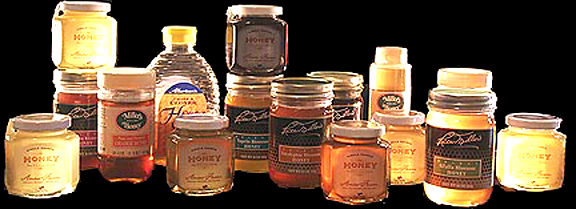
Some of the honeys used for my taste comparisons.

Wayne Schmidt's Artisanal Honey Page Pictures of and taste comparisons of single-source honeys.

Some of the
honeys used for my taste comparisons.
What
This Page Is About:
Artisanal or varietal honeys are honeys made from a single species of flower. Because each variety of flower has a particular type of nectar the varietal honey made by the bees that visited that flower has a particular flavor. These honeys can be difficult to find but the reward is a palate of flavors unavailable from the standard brands found in grocery stores. This page shows what 14 of the most common varietal honeys look, smell and taste like.
A
Problem With Purchasing Artisanal Honey:
There's something about artisanal honeys of which potential buyers need to be aware: what's on the label may not be what's in the jar. Consider the following three samples of buckwheat honey purchased on-line and from a local farmer's market:
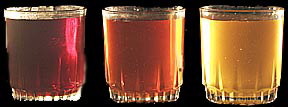
All three were labeled as being 100-percent pure buckwheat honey, a honey reported in the Honey.com site (sponsored by the National Honey Board) to be very dark amber, purple or black with a strong molasses flavor. Of the three I purchase only one, on the left, matched this description. The middle one was amber and the one on the right a very light amber. Both the middle and right honeys tasted like clover honeys. What's going on?
The answer is that for a company to label a honey as being a varietal honey it only has to consist of 51-percent of that particular type of honey. The remainder can be a cheaper honey (this makes it a blended honey) or the fields from which the nectar for the honey was collected could contain different flowering plants up to 49-percent of the total. In either case the amount of the variety of honey that is listed on the label has been diluted to the point where what's inside probably won't taste like it's supposed to. Even worse, it's possible that some unscrupulous honey suppliers could mislabel a cheap honey as a more expensive varietal honey, as I believe happened with the honey on the far right. This sample was obtained from a farmer's market in which three 10-gallon honey kegs with spigots sat next to each other. Although they were labeled as being three different types of honey, the honey dispensed from each was the same color, thickness, and had the same taste. It seems clear that in this instance the seller or supplier was counting on consumer ignorance to get away with selling a cheap honey, which I believe was clover, for more expensive varietals.
The only way for people to protect themselves from this sort of misrepresentation is to become knowledgeable about honey and purchase their honeys from a reliable source.
The
Best Source of Varietal Honey on the Internet:
After researching dozens of different on-line sources of varietal honey and purchasing honey from many of them, I've come to the conclusion that the best and most reliable company is without a doubt Ames Farm (http://www.amesfarm.com) a honey farm with 300 hives spread throughout Minnesota.

Some
of the outstanding honeys I've purchased from Ames.
Note
the variation on colors, proof that these are pure varietal honeys.
I have purchased seven of their honeys and each matched perfectly the color and taste descriptions listed in the Honey.com site. Additionally, their honey jars are the most professional looking jars of any manufacturer I've found. While this doesn't effect the quality of the honey inside, I assume that someone who works as hard as the people at Ames do to make their product look good are also going to have the pride to fill the jars with the best and purest kinds of honeys. I heartily endorse Ames as the best place to go for honey.
(Important note: I don't own stock in Ames Farm, they are not paying me for this endorsement and they did not ask me for it. I'm posting it simply because they earned it by producing a top-quality product.)
An
Important Comment About Varietal Honeys:
Varietal honeys are not like the bland, heat-pasteurized honeys found in supermarkets. Even the mildest varietal will have a strong assertive flavor that may be a shock to the unprepared. Their bold flavors may not be what many people are used to and because of this may not like them at first. The only way to know is to sample several and decide for yourself.
About
the Taste Tests:
I am not a honey expert and am not a professional or even an experienced taster. I'm just an average person and consequently may not be able to identify some subtle flavors or if I do, may not be able to properly express them in appropriate culinary terms.
When smelling or tasting a honey I prefer to write down descriptive words that capture the essence of the overall flavor. These may include words like medicinal or detergent, which may sound negative but aren't meant as such. Honey is a very difficult food to describe because many of its flavors are so unique that there are no satisfactory descriptive analogies.
All of the images of single-varietal honeys that follow were taken with a strong light shining through them to capture as much of the honey's true color as possible. These may differ slightly when you see these honeys in person because the lighting will be different and/or the containers were larger or smaller in diameter, which will make the honeys appear correspondingly darker or lighter. The written color descriptions are closer to what the honeys look like under normal lighting.

Alfalfa:
extremely light amber, strong pungent aroma, strongly medicinal
flavor with a sharp edge.
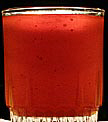
Avocado:
very dark amber, mellow spicy aroma, rich flavor, hint of molasses, buttery
(Four
additional taste testers all agreed that this was the most
interesting of all the honeys.)
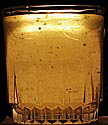
Basswood:
extremely pale amber, almost as clear as water, medicinal, spicy
aroma with a high note,
smooth,
sweet mellow starting flavor with a strong medicinal finish.
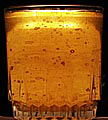
Birdsfoot
trefoil: very light amber, strong quintessential honey aroma, sweet
flavor with a hint of detergent, slight medicinal after taste.

Buckwheat:
Purple to black turning deep wine red with a strong light shining
through it, almost opaque, burnt, spicy aroma, strong molasses flavor.
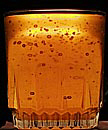
Dutch
clover: light amber, strong medicinal aroma and flavor but mellow,
not harsh.

Milkweed:
extremely light amber, very thin, spicy aroma and flavor with a mild
medicinal note.
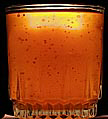
Eucalyptus:
dark amber, strong, spicy, burnt aroma, intense, sharp medicinal flavor.
The
was the least favorite of the four additional tasters.
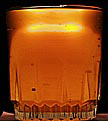
Orange
Blossom: pure amber, the quintessential honey color, sweet, spicy
aroma with high notes, rich, smooth, fruity flavor with a sweet
finish. Very good. The second most preferred flavor of the four
additional testers.

Sage:
light amber, no aroma, very sweet, the purest honey flavor, high
notes that are hard to describe but wonderful to taste. My favorite
and the most preferred by the four additional tasters. (Note:
the sample I purchased was the Miller's brand from a supermarket and
I assume it had been heat pasturised, a process which tends to mellow
flavor. Unpasturised sage honey may have a stronger taste. The same
can be said for the orange blossom honey I tested.)
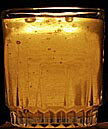
Sweet
clover; extremely light amber, very thick and viscous, sweet aroma
with high notes, sharp, tangy flavor with a chemical edginess, after
taste had a slight burn.
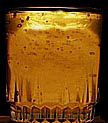
Tupelo:
light amber, burnt hint in aroma, minty, spicy flavor.
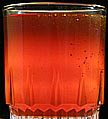
Tulip
poplar: reddish-amber, very rich and mellow aroma, extremely sweet
with
a strong aromatic note to the flavor. Good

Sourwood:
light amber with little aroma, sharp, spicy, edgy flavor with a
distinctive
high note.
What
They Look Like in Real Use:
While looking at varietals in jars is interesting, what they really look like is how they appear in actual use, such as in the following two images with dabs of them on buttered bagels and a third image of three samples on a piece of buttered bread:

Clockwise
from upper left: buckwheat, sweet clover, dutch clover, alfalfa,
birdsfoot trefoil, basswood.
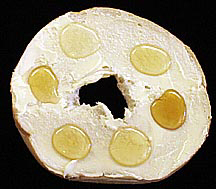
Clockwise from upper left: milkweed, tupelo, avocado, sage, orange blossom, eucalyptus.
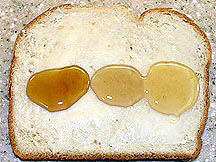
From left to right: pulip poplar, sourwood, and sage (for comparison.)
NEW!!! Seven Additional Honey Tests:

Lavender honey: Very light amber, no aroma, pleasantly sweet with a subtle floral note, mellow, very interesting and good.
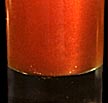
Manuka:
Reddish-brown color, buttery aroma that oddly reminded me of
Canadian bacon, thick, sharp medicinal flavor.
High
pollen content makes it look cloudy, but it has no trace of grittiness.

Leatherwood: Orange-gold color, from a flowering tree in New Zealand: Slight chemical aroma that actually reminded me of leather, extremely medicinal, not good.
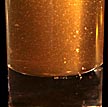
Black Button Sage: Light amber, buttery aroma, tastes similar as Miller's sage but much harsher. Steps over the line from mellow to being overly strong and harsh.
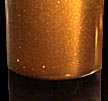
Yellow Star Thistle: Light amber, no aroma, pleasant, interesting hint of fruitiness.
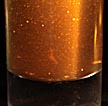
Fireweed: golden amber, no aroma, very medicinal, like Manuka but not quite as strong.

Hawaiian Lehua: Cloudy gold, weak honey fragrance, overly strong chemical butteriness, like artificial butter flavor.
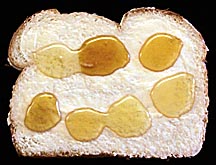
Clockwise from upper left: Lavender, Manuka, Leatherwood, Black Button Sage, Yellow Star Thistle, Firewood and Lehua
Final Words About the Taste Tests:
The overall winner was Miller's Sage honey available in most supermarkets. While most of the high priced, gourmet honeys had stronger flavors, none provided a better overall eating experience. (Please note: I have no connection with Miller's Honey and they have not paid or asked me for this endorsement. I'm only reporting the unanimous result of the taste test panel. I'm mentioning this honey by brand because that's the one we tested. I can't comment on sage honey from other manufacturers.) The second most prefered type was orange blossom (again by Miller's) followed closely by avocado from Ames and finally lavender honey by Mas des Abeilles in fourth place.)
Honey preferences are extremely personal. Some of the honeys I didn't like were raved over by others and visa versa. The only way to really know which honey you prefer is to test as many as possible and decide for yourself. As for me: I put sage at the top of the list followed closely by orange blossom and avocado.
I sincerely hope you enjoyed this page as much as it did putting it together. Thank you for visiting.
(Click on main site to go to my main page and browse 70 topics ranging from triangle looms and Knitting Nancies to the strange world of lucid dreaming.)